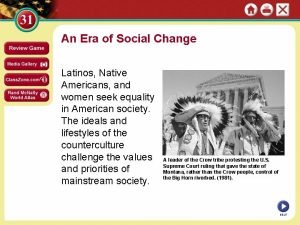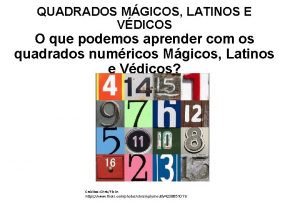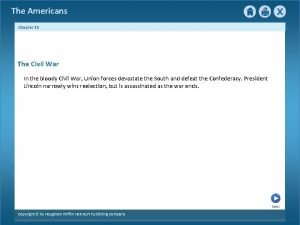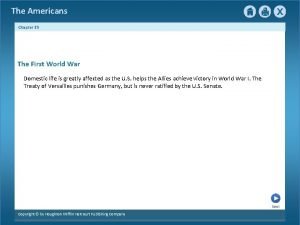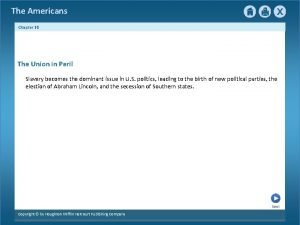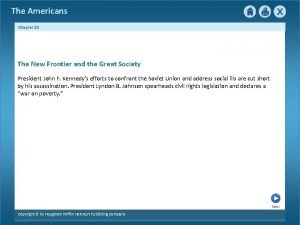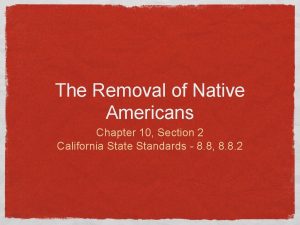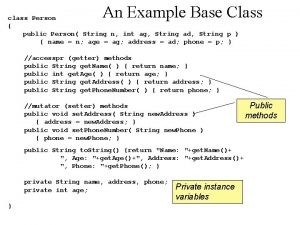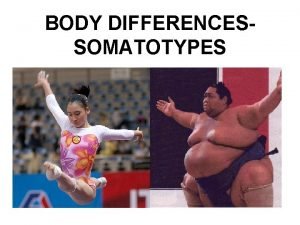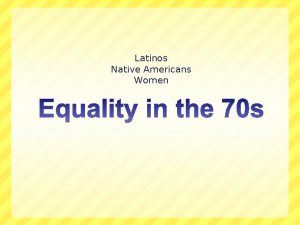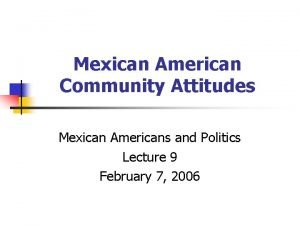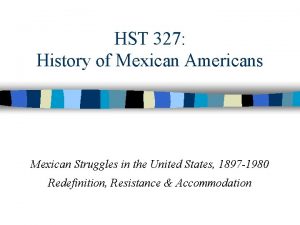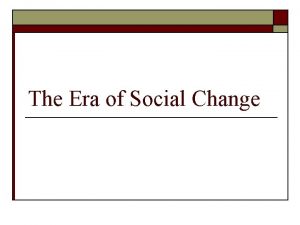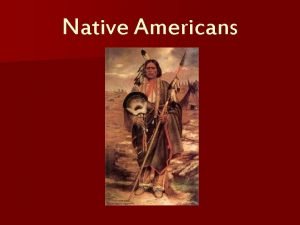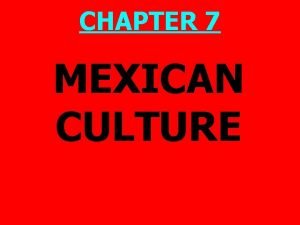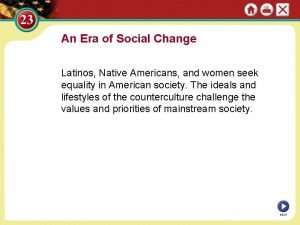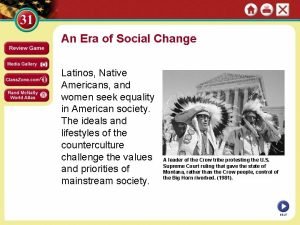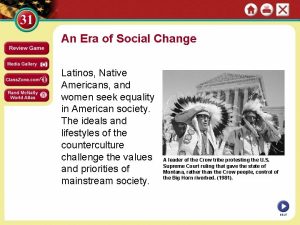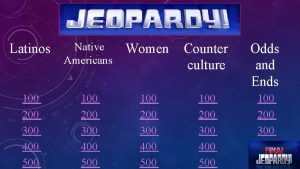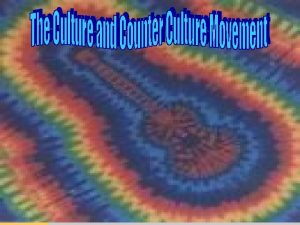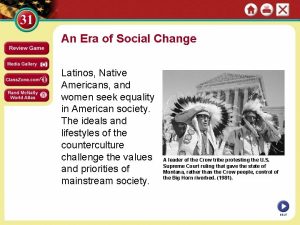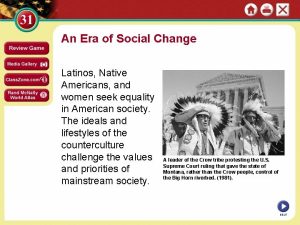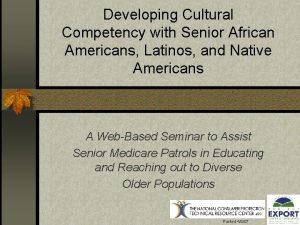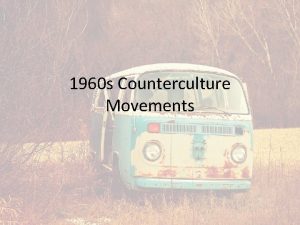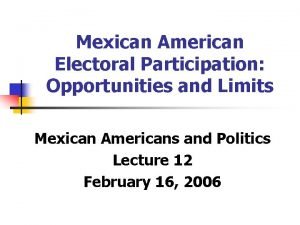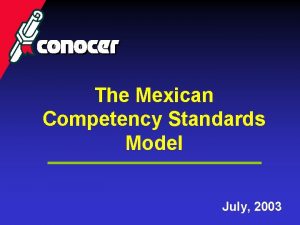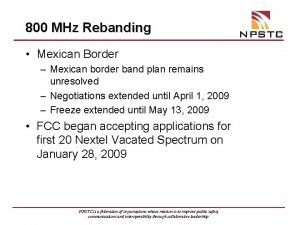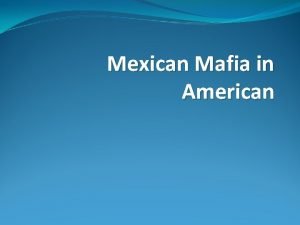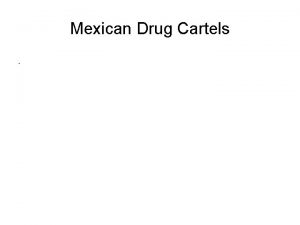MEXICAN AMERICANS CHAPTER 8 Latinos Persons whose national














































- Slides: 46

MEXICAN AMERICANS CHAPTER 8

• Latinos • Persons whose national origins (or whose ancestors’ national origins) are in the countries of Latin America • • Caribbean, Central and South America Hispanic • An English word derived from Hispania • Roman name for Spain

THE CONQUEST PERIOD, 1500 -1853 • • In 1500 s, Spaniards conquered; sought to Catholicize indigenous population in Mexico and southwestern U. S. for economic exploitation Offspring of sexual liaisons • Mestizos • • Mixed people Outnumbered colonizers

Depiction of casta system in Mexico from the Museo Nacional del Virreinato.

Las castas. Anonymous, 18 th century, oil on canvas, Museo Nacional del Virreinato, Tepotzotl, Mexico.

Casta Paintings: Inventing Race Through Art Mexican Art Genre Reveals 18 th-Century Attitudes on Racial Mixing - June 2004 LA County Museum of Art The upper-class Spaniards views on race, class and skin color during the 1700 s, when Mexico was a colony of Spain… "De Espaniol y Albina, Torna Atras" = "From a Spaniard and Albino, return backwards. "

1821 Mexican independence 1830 s Anglo American presence The Texas Revolt: (1820 -1830 s) • • Mexican government: freed enslaved people and placed restrictions on U. S. immigration, Texas rebellion • • U. S. settlers go beyond an existing boundary and intentionally aim to create new territory (Texas portion of Mexican state Coahuila y Tejas) 1836 Republic of Texas; 1845 joins US 1848 Mexico surrenders ($15 million) Treaty of Guadalupe Hidalgo


The Mexican Cession agreed by Mexico (White) and the Gadsden Purchase (Brown). Part of the area marked as Gadsden Purchase near modern-day Mesilla, New Mexico, was disputed after the Treaty. (1853)

California and New Mexico • • • Discovery of gold in 1849 led U. S. Anglos to enter California At the time of acquisition, the 50, 000 Mexicans in what is now New Mexico had long maintained cultural traditions Soon many lost their lands to invading whites

PAST AND PRESENT IMMIGRATION • Immigrants include: • • Those with official visas Undocumented Immigrants or Illegals • • Braceros • • Seasonal farmers on contract Commuters • • Immigrants without legal immigration papers Those with official visas that live in Mexico but work in U. S. “Border Crossers” • Domestic workers with short-term permits

Braceros and Undocumented Workers: Encouraging Immigration • • 1924 Immigration Act; 1929 “illegal entry” is a felony 1942 Emergency Farm Labor (Braceros) Agreement • • • Between U. S. and Mexico to provide Mexican workers for agriculture Today they are not rural migrants but come from urban areas in Mexico U. S. economy depends on immigrants from Latin America • “Backbone” of Dole, Green Giant, Mc. Donalds, Burger King, Del Monte, etc.

• • U. S. involvement in Latin America long involved U. S. government and major corporations Most immigrants pulled by U. S. jobs Pushed by serious economic problems Maquiladoras (1960 s) • Manufacturing operations in Northern Mexico near the U. S. border, where they can take advantage of low-wage labor and weak environmental standards while avoiding certain tariffs and duties

On Maquiladoras… Corp Watch http: //www. corpwatch. org/article. php? id=1528 On vioence against women… Femicide along the border http: //www. libertadlatina. org/Crisis_Lat_Mexico_ Juarez_Femicide. htm

• NAFTA – North American Free Trade Agreement • • Accelerated U. S. investment and manufacturing in Mexico Approx 12 million undocumented • • • Most are temporary labor migrants caught by INS and do not intend to live in U. S. Large reverse flow into Mexico goes unnoticed and unreported Most pay more in income and other taxes than they receive in government benefits

• 1986 Immigration and Reform Control Act (IRCA) • • • Legalization of undocumented immigrants in U. S. since 1982 Sanctions for employers who hire undocumented aliens Reimbursement of government for cost of legalization Screening of welfare applicants for migration status Programs to bring in agricultural laborers 1. 7 of 3 million applications accepted

• 1996 Illegal Immigration Reform and Immigrant Responsibility Act (IIRIRA) • • Established regulations restricting legal immigration as well as undocumented immigration 2006 Secure Fence Act • • • Estimated to cost $35 billion Increased number of border enforcement personnel and surveillance technology Construction of physical barriers to Latin American immigrants including doublelayered fence to be completed by 2008

In a country of immigrants, a(nother) case of social closing: Arizona Senate Bill 1070 Signed into law April 23, 2010: It is the 1 st state to demand that immigrants meet federal requirements to carry identity documents legitimizing their presence on American soil. An example of prejudice, discrimination, and xenophobia.

Population and Location • • “Latinos” - fastest growing major racialethnic segment of U. S. population. Approx 42 million. Latino population in Los Angeles now larger than population of numerous states • • More than one third of the residents of California, largest state California and Texas have population majorities that are not European American

Conflict and Protests Since the 1960 s • Brown Berets, Chicano Movement • Chicano Studies departments • Cesar Chavez (March 31, 1927 April 23, 1993) Latino civil rights activist and founder of the United Farm Workers Delores C. Huerta (April 10, 1930 - )

THE ECONOMY • • Mexicans initially incorporated into U. S. economy by often violent conquest and takeovers of Mexican lands Mexicans were original Vaqueros • • Spanish word for cowboys Late 1800 s to early 1900 s • Working conditions in agriculture were often severe and wages very low • • Few whites competed for these jobs Women concentrated in agriculture, domestic service, and manufacturing

• Continuing Language Discrimination Language discrimination in workplace involves treating people unfairly because they speak language other than English • • Garcia v. Gloor (1981) • • • EEOC reports increase in complaints Supreme Court upheld firing an employee for speaking Spanish Lawsuits over language discrimination more common in recent years Language discrimination periodically draws protests from Latinos

Unemployment, Poverty, and Income • Latino unemployment rates relatively high for decades • Mexican American incomes consistently low compared with whites • Poorest families include workers immigrated in recent decades with little education or economic capital • U. S. has predominantly service-worker economy with decreasing industrial jobs



• Recent research shows two divergent patterns of economic mobility • • Earning of low-skilled, foreign-born Mexicans decrease as immigrants reside in U. S. longer Earning of high-skilled, foreign born Mexicans increase as immigrants reside in U. S. longer Movement of large numbers of immigrants into Latino communities buttressed local economies and maintained a demand for businesses that provide Latino goods and services Extended family and strong cultural frameworks remain at core of communities

Immigrant Workers: Targeted for Discrimination • Mexicans now neighbors of other Americans in all U. S. regions • • Yet, other Americans treat them as outsiders Growing numbers report housing and related discrimination by white neighbors Housing discrimination plagues Latino families, both immigrants and established citizens Patterns of discrimination led to Latinos living in Latino-majority neighborhoods

POLITICS AND PROTEST • • • Before 1910 only a few hand-picked Latinos held office in territorial and state legislatures in the southwest Gerrymandering in some districts diluted Latino voting strength and prevented election of Latino candidates Voter registration and turnout of Latinos have risen over past three decades

• • Growing Political Representation Recent surveys indicate Latinos are committed to working together to increase political participation and political power National Association of Latino Elected and Appointed Officials Educational Fund • • • Empowerment organization for Latinos Played major role in increasing Latino voter registration and turnout Between 1960 s and mid-200 s number of Latinos in state legislatures increased significantly and are overwhelmingly Democrats

• The Courts and the Police Mexican Americans long underrepresented in judicial system • • All together, Latinos make up 11% of police but only 6% of first-line supervisors • • First judge appointed in 1960 s 3. 5% of lawyers and 6% of various judicial workers Arizona, California, and Colorado require jurors to speak English, screening out many citizens • Recent survey found only 35% felt they receive fair outcome when dealing with the courts

The Chicano Political Movement • • Social movement that sought greater political power and less discrimination for Mexican Americans La Raza Unida Party (LRUP) • • • Goals include significant representation in local governments and pressing latter to better serve Latino communities Mexican American women held important roles in LRUP Feminism easy because of woman’s traditional roles and strength as center of family

• Other Organization and Protest Union organization has long history among Mexican Americans • • 1 st was Confederacion de Uniones Obreras Mexicanas (CUOM) (1927) American GI Forum • • Chicanismo • • Formed after Texas cemetery refused to allow burial of a Mexican American WWII veteran A philosophy of self-esteem and antiracism Mexican American Legal Defense and Education Fund (MALDEF) • Address problems of jury discrimination, police brutality, and school segregation

Unions for Low-Wage Workers • Agricultural Workers Organizing Committee (AWOC) and National Farm Workers Association (NFWA) • • Agricultural Labor Relations Act (1975) • • Created by Jessie Lopez, Dolores Huerta, and Cesar Chavez Provided for protection of union activities Many Mexican American and other farm workers still get low wages across the country • Increasing number members of mainstream unions

• • Other Recent Challenges: Latinos and African Americans Growing number of Latino population in urban areas have led to political conflict and cooperation with African Americans Modern capitalism sometimes pits new immigrants against established citizens who rely on lower-wage blue-collar and service jobs • • General political competition between Latinos and African Americans also generates conflict White-controlled media focuses more on conflict and neglects cooperation

EDUCATION • Mendez v. Westminster (1946) • • • Federal judge ruled that segregation of children in “Mexican schools” in California violated the 14 th Amendment Anticipated Supreme Court ruling in Brown v. Board of Education For decades, some schools with high percentages of Latino students prohibited all manifestation of Mexican American subculture • “Six-hour retarded” • Functioned well in the outside world but mislabeled by school discrimination and poor testing

Current Education Issues: Segregation and Bilingualism • • • 2000 s, too many Mexican American children placed in learning-disabled classes, textbooks still neglect Mexican American history, and de facto racial segregation persists Children with limited English proficiency become discouraged, develop low selfconfidence, and fail to keep pace with English speakers Myth propagated by nativists is that bilingual education is ineffective

• • Educational Achievement Mexican American attainment lowest of three Latino groups Dropout / “pushout” rate is high • • Education highly valued by students and their families • • Poverty and need to earn money to help relatives is an obstacle 9 out of 10 believe college education important Steps to improve public education • Include Spanish language and Mexican American culture, involve parents, increase meaningful interaction between teachers and students


ASSIMILATION OR INTERNAL COLONIALISM • Assimilation theorists • • • 10, 000 initially brought by U. S. conquest Most arrived later voluntarily and generally improved their economic circumstances relative to those in Mexico Aspects of traditional culture have begun to disappear as acculturation proceeded • • Yet, substantial degree of Mexican cultural heritage persists Bilingualism • The ability to speak two languages

• One U. S. problem is structural • • Private and public organizations do not now provide enough language training Widespread use of English among immigrants underscores error of xenophobic calls for English-only laws and school policies Structural assimilation, especially economic upward mobility, has come slowly for many Behavior-receptional and attitudereceptional assimilation have varied considerably

The Limits and Pacing of Assimilation • Structural assimilation or marital assimilation reached a high level • 1970 s study revealed some intergroup friendship contacts • Significant numbers demonstrate movement toward identificational assimilation • • Indicates diversity of opinion Racial and ethnic identification varies with class, age, experience and whether self-defined or imposed

• Structural socioeconomic incorporation also limited • • • Ease of movement and incorporation into white institutions varies with perceived class and skin color As long as there are major immigration streams from Mexico into Mexican American communities, traditional assimilation will be slowed Latinos interested in developing or viewing their own mass media • Fastest growing television audience in 2000 s

Applying a Power-Conflict Perspective • Internal colonialism analysis • • Mexican American history began with ruthless conquest of northern Mexico Problem in applying traditional colonialism perspective • • Most entered as voluntary immigrants after initial conquest Most significant difference between Mexican and European immigrant experience • Intensive discrimination and cultural subordination of later Mexican immigrants in U. S.

• Mexican immigrants entered environment in which progress and mobility generally limited • • Internal colonialism analysts • • Low wages, inferior schools, and various types of racialized discrimination White employers intentionally created a split labor market from which they received enormous profits Power-conflict analysts • Emphasize continuing reality that majority of whites still see Mexicans as not white

A Pan-Latino Identity • • • Anti-Latino discrimination has led many Mexican Americans to adopt a broader Hispanic or Latino identity Collective Latino/Hispanic consciousness developed since 1960 s Pan-Latino process emerged as a political strategy to accomplish political goals shared by component groups • Facilitated by shared language and similar home cultures

Further Reading: Acuna, Rodolfo F. (2011), Occupied America: A History of Chicanos (7 th ed. ), Boston: Longman
 Latinos and native americans seek equality
Latinos and native americans seek equality One person's trash is another person's treasure
One person's trash is another person's treasure Quadrados latinos sudoku
Quadrados latinos sudoku Bajo la misma luna where to watch
Bajo la misma luna where to watch The americans chapter 11
The americans chapter 11 Chapter 19 the americans
Chapter 19 the americans The americans chapter 18
The americans chapter 18 Chapter 15 immigrants and urbanization
Chapter 15 immigrants and urbanization The americans chapter 10
The americans chapter 10 The americans chapter 28
The americans chapter 28 The americans chapter 10
The americans chapter 10 Liable
Liable The vulnerable persons living with a mental disability act
The vulnerable persons living with a mental disability act Married persons equality act 1 of 1996
Married persons equality act 1 of 1996 The principle of respect for persons
The principle of respect for persons Missing child montana
Missing child montana Older persons act norms and standards
Older persons act norms and standards Trinity
Trinity The principle of respect for persons
The principle of respect for persons The principle of respect for persons
The principle of respect for persons Escala de sad persons
Escala de sad persons Some common trafficking in persons contract violations
Some common trafficking in persons contract violations Chapter 25 suicide and nonsuicidal self injury
Chapter 25 suicide and nonsuicidal self injury Class of persons examples
Class of persons examples Personbunden fortæller
Personbunden fortæller Famous persons
Famous persons Dance of caring persons
Dance of caring persons This is a person's essential being that
This is a person's essential being that High close doji
High close doji People, places, things, or ideas
People, places, things, or ideas Mobility examples ap human geography
Mobility examples ap human geography Livelihood opportunities for persons with disabilities
Livelihood opportunities for persons with disabilities Persons in lpscs careers must effectively communicate with:
Persons in lpscs careers must effectively communicate with: Exchange of ideas between two or more persons is
Exchange of ideas between two or more persons is Mesomorph sports persons names
Mesomorph sports persons names Livelihood programs for persons with disabilities
Livelihood programs for persons with disabilities Sad persons scale nursing interventions
Sad persons scale nursing interventions Persons
Persons Proper noun of author
Proper noun of author It is name of persons places or things
It is name of persons places or things Escala sad person
Escala sad person Trichomoniasis pictures
Trichomoniasis pictures What is trafficking in persons
What is trafficking in persons The exchange of information thoughts ideas and feelings is
The exchange of information thoughts ideas and feelings is Parchiatry
Parchiatry One face one voice one habit and two persons
One face one voice one habit and two persons Example of subject pronoun
Example of subject pronoun
